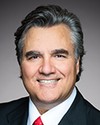Mr. Emerson, perhaps I could add a point.
Our trade lanes are also changing in Canada. When we look at the Asia-Pacific gateway, we had and continue to have a lot of focus on China. Also, with the growth in our agricultural exports to India, we have a number of our products going to India via the east coast, via Montreal. The steamship lines, in particular on the container side, are transshipping out of Europe via the Suez Canal to hit India on a transit time that's actually very efficient.
I think the priority we have both on growing our trade with countries like Turkey, North Africa, and India and, of course, with the CETA, the Canada-Europe trade agreement, is going to make that eastern gateway very important for us going forward. Containerized shipping out of Montreal, the Great Lakes, and the Quebec seaway port access are certainly priorities for our company and for others in the industry.




